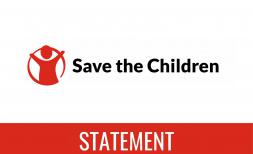In Afghanistan, rains bring little relief for 12 million children struggling to recover from drought

KABUL, 19 April 2022 – About two in three children in Afghanistan – or 12 million – whose families depend on farming to survive, are struggling to get enough to eat daily due to the country’s worst drought in decades and forecasts of below-average rains this wet season, Save the Children said.
Afghanistan’s economy is heavily reliant on agriculture, with around 61% of all households[1], or 25 million of the 40 million population, depending on farming for their livelihoods. Many families have been left destitute and on the brink of starvation after consecutive seasons of poor rainfall devastated crops, sent livestock prices tumbling and dried up water wells.
The country is facing its worst food crisis since records began, with 5 million children on the brink of starvation.
While March saw above-average rainfall, snowpack on Afghanistan’s peaks has remained below-average and is now rapidly declining due to warming temperatures. Forecasts suggest below-average rainfall is most likely during the remainder of the wet season,[2] which the agency warns could make things even worse.
Save the Children said farming families are continuing to resort to desperate measures such as selling off livestock, borrowing money they cannot pay back or taking children out of school to send them to work, from which they will be unable to recover for years to come.
Mohammad*, 46, lives with his wife and eight children in rural Faryab Province in northern Afghanistan. Like most people where they live, the family relied on farming for their food and income. When the drought hit, Mohammad’s crop failed and he had to sell most of his animals because he couldn't afford to feed them. He now only has one cow left, but he plans to sell her too. Save the Children is providing the family with cash assistance to help them buy food.
“I used to earn my living through farming and I had animals. We used to grow wheat, melons and oil. When there is no rain the land is dry and we can’t grow anything,” Mohammad told Save the Children. “Now our lives are not good. People have nothing – they lost their animals and their farms. The drought completely devastated our land.
“Now we must rely on aid. The money I got from selling my animals has already been spent, and there is no money left. So when this money [from Save the Children] runs out I hope God will send more aid here.”
Faryab has been ravaged by war for decades, and drought has brought yet more tragedy. The northern province is one of the hardest hit: 65% of its 1.5 million population is now facing emergency or crisis levels of food insecurity, and more than a quarter of people are reliant on aid for between 25-50 percent of their daily food needs. The wells in Faryab that people like Mohammad relied on are now totally dry.
“The drought has brought so many problems I don’t know where to start,” Mohammad said. “The children have become so weak and thin.”
As the negative impacts of climate change intensify and the planet continues to warm, Afghanistan will experience more extreme weather events, which will increase the risk of conflict over scarce resources, food insecurity and poverty.[3]
The current dry spell has also coincided with political and economic turmoil in Afghanistan. Following the transition of power last August, international governments pulled vital financial support and froze assets. The economy and basic services to protect, educate and provide healthcare to children have since largely collapsed.
Last month, governments pledged US$2.4 billion for humanitarian relief in Afghanistan and neighbouring countries – leaving a US$2 billion gap in the humanitarian response. Crucially, without action to stabilise the economy, more and more children will be pushed to the brink of hunger and poverty.
Save the Children’s Country Director in Afghanistan, Chris Nyamandi, said:
“With Afghan assets still frozen, families have no way of getting back on their feet after the numerous blows that the last year has dealt them. Humanitarian aid can alleviate urgent needs, but it can’t prop up an entire economy.
“Until we address the economic crisis, families will have no other option but to resort to desperate measures like selling their children or sending their children to work, which there is no way back from. With so much of the country already on the brink of famine, time is of the essence.”
Save the Children is providing families with urgent cash assistance, which helps to prevent families resorting to desperate measures like cutting back on meals or taking their children out of school. Since September the agency has reached more than 1 million people – including more than 596,000 children – and provided 166,456 people with food security and livelihoods support.
The content is available here: https://www.contenthubsavethechildren.org/Package/2O4C2SSKH7G2




